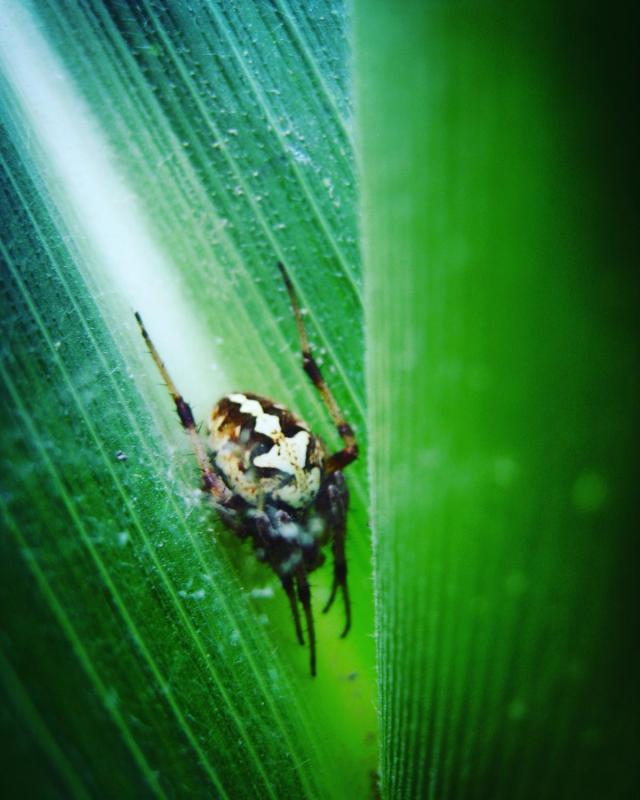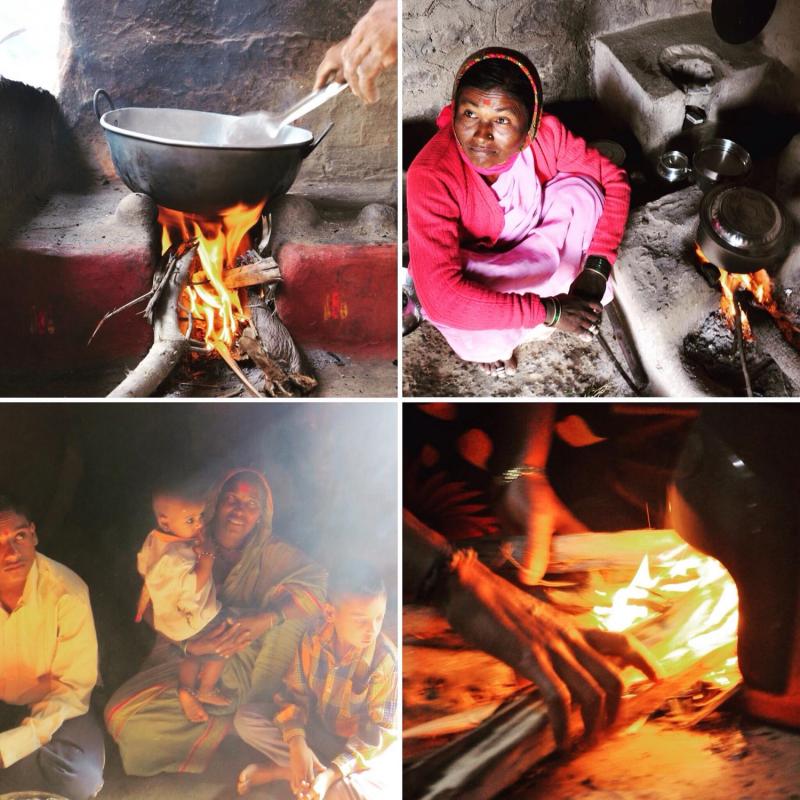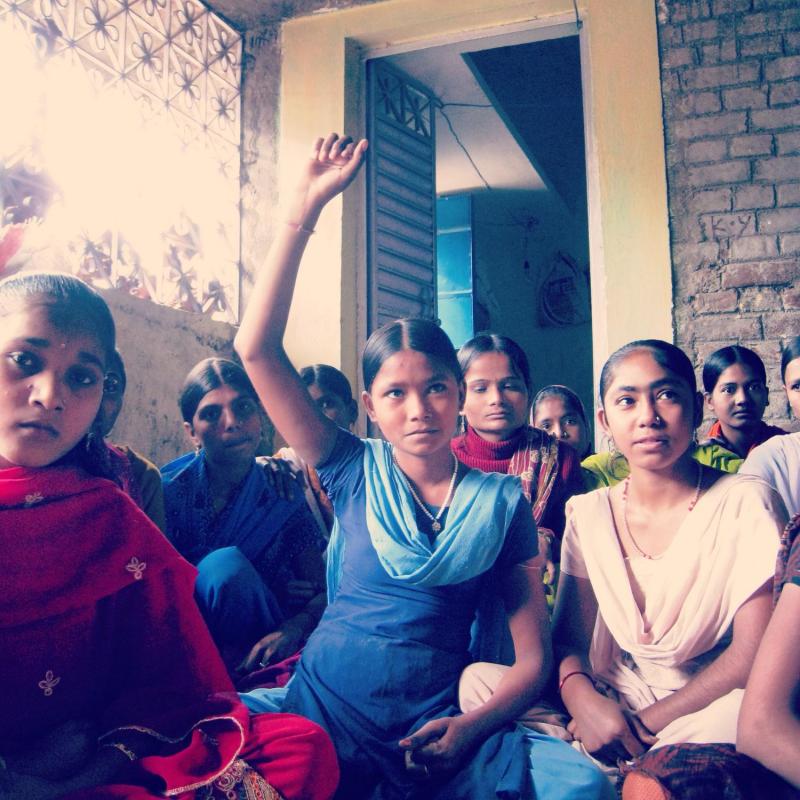Harvest
Her fingers flutter across the stalks from bloom to bloom, like bees pollinating, like a bird seeking seeds. She tosses the cotton into a sling slung across her back. I reach for a boll, unprepared for the thorns that encase it, protecting the soft interior, the billowy seed head that opens into five folds. The woman—I never catch her name, meet her only fleetingly—and her fellow harvesters are artists. I am not. I yank awkwardly at the cotton. She laughs, her face framed in gauzy orange fabric. That one’s not ready, she motions, laying her hand upon mine, guiding me. We are surrounded by acres of cotton, the Punjabi state of cotton, the Indian nation of cotton. Though the farmer who has brought me here to his land is switching to organic on some of his land, in this field he grows from genetically modified Bt cotton seed. In this field, he sprays, but less with the Bt variety. “When I was growing non-Bt cotton, I would be using twelve to thirteen pesticides—broad-spectrum organophosphates—the worst ones,” he tells me. “But with Bt, I use maybe four or five sprays.” It’s what Monsanto brags about, this reduction of chemicals with Bt cotton. In 2002, the Indian government approved Monsanto’s cotton and it now dominates the market, pushing the old varieties that emerged from this region to the fringes. But the farmer knows: When one pest goes, another arrives. The woman before me is focused on her harvest. With cotton at six rupees per kilo, a good day will yield her a dollar. The cotton is piled at the end of field rows, loaded onto the bloated backs of trucks, added to downy mountains overflowing from concrete-walled depots in town, bound into bales, sorted through, and eventually spun into cloth in a factory far from Gandhi’s spinning wheel.
Intoxicated
They sit beside a canal—two farm laborers taking a chai break in the shade of a tree, their bodies suspended on a single charpoy cot. The air is hot and still. Jasbeer, thirty, scowls as he speaks of his work on fields saturated with industrial pesticides and fertilizers. Diammonium phosphate, urea, diafenthiuron, cartap hydrochloride. The spent bags of chemicals are speared onto sticks at the edges of fields, marking the application, marking the boundary. Bags lie empty on the roads, repurposed as sacks to slip a lunch tiffin into, and maybe a scarf for cool mornings.
“I don’t like the chemicals,” one laborer says, standing up. “I feel intoxicated by them, in a bad way.” The canal behind him is brown and slow. They use the canal water to top off backpack sprayers filled with concentrated chemicals. They walk through the fields—barefoot, maskless—pumping a mist onto the greenery. “I really detest it because I work with poisons all day and it makes me want to drink at night,” he says. “I’d prefer to work on a natural farm.” The natural farms—where the chemical fertilizers and insecticides are forsaken for a more sustainable approach—are tiny organic islands in a sea of chemically treated lands. “[But] I can’t afford to do it without chemicals,” he says, “so it doesn’t matter if I don’t like it.”
Edible Earth
Like his mother, Gora Singh came to believe there is a health benefit to farming without chemicals. He pokes at the earth with his daati, a small sickle-shaped tool with a sharp blade, as we sit in the dirt on the edge of his five-acre farm in Punjab. The implement is an extension of his body, digging device and slicing mechanism, pointer and harvester. Gora tells me that he switched to natural farming four years earlier, when his mother, still alive but sick, asked him to stop using the pesticides that she believed were the cause of her illness. He had always used chemicals, he said, because he didn’t know that you couldn’t. Now, half his land was organic and he was transitioning the rest.
He is a man delighted. The biggest change, he says, was in the soil. He presses harder into the daati handle and lifts up a handful of earth, then crumbles the soil and holds it to his nose. “Organic soil smells so good,” he says, holding it out to me like an offering, a circle of red henna revealed at the center of his open palm. I hold the handful of earth to my own nostrils, so close that a clump sticks to the end of my nose. It does smell sweet, almost edible. Like a wild mushroom. Though the surface of the ground where we sit is cracked, the dirt is laced with the aroma of rain on dry earth, the scent of petrichor—the word a marriage of the Greek word for stone—petros—with ichor, the fluid that runs through the veins of Greek gods. During dry periods, plants exude oils that permeate the soil they inhabit. When moisture arrives, the bouquet is released along with geosmin, a metallic by-product of natural bacteria. Without pesticides, the soil is more complex and can retain water for longer. It is richer, darker, and heavier, containing a living history of weather, wind, sunlight, plant redolence, and microscopic bacteria. It is alive.
Strike the Match
Malan Kolekare tends her fire. The act is older than history itself. Strike the match. Flick the flint. Lean in and blow just enough to feed the flames that make the fire that cooks the food that nourishes the family. Collect the wood, the dung, whatever is at hand, whatever is free. Add it to the ever-diminishing pile by the stove. Do it again. A non-profit gave her an improved cookstove, promising that it was “smokeless.” She didn’t notice an improvement, so she set it aside. Another neighbor used one until it broke a few months later, and then set it aside, too. Another says the smoke goes up and away, disappears under the eaves of the half-enclosed space that serves as her kitchen, so why not just keep the old mud stove she’s used to, that toasts the bread just right? Another neighbor, who scowls into the thick smoke in the contained shed with the tiny window where she cooks on her double mud stove, shrugs the smoke away. She sets her small child near the fire, his eyes tracking the flickering flames, mucus seeping from his nose. Three billion people around the planet stoke such flames to feed themselves, not deciding between the four-burner or the six. Not debating if stainless steel is still in vogue. Just starting the biomass fires that create the greatest health risk in the world—killing more than malaria, tuberculosis, and HIV/AIDS combined. The second worst risk for females, except in India. In India, it is the worst. Malan stirs the eggplant curry simmering over the open blaze, the boil breaking the surface as the fire pops below, the air redolent with roasting spices.
Unintended Consequences
Rameshewar and his wife, Pandevi, are skinners. We stand outside their hut where they have lived with their children for years, a hundred yards from a five-acre pile of corpses. Once, this land was the grazing grounds for a large camel corps, here on the outskirts of Bikaner, in the Thar Desert of western Rajasthan. The army has since upgraded to more modern and efficient means of transportation, and the expanse of desert was reallocated as a carcass dump. Cows, goats, camels, dogs, by the truckload they come. Once, India’s scavenging population of vultures consumed the dead where they died, underappreciated sanitation workers, always on call. Then the great birds vanished, the unintended consequence of pricking livestock rumps with the pharmaceutical drug diclofenac. Such a highly effective painkiller. Eases the limp of an ailing ox, the swollen udders of a cow. But if the livestock dies, and the vultures feed, that is the end of the birds’ lives. No tolerance for the drug diclofenac. Bye, bye, birdie. Forty million gone in a decade.
When the carcasses arrive, Rameshewar and Pandevi remove the hides for leather, then pile up the remains for the other scavengers to dismantle, the dogs dominating the space the vultures once held. The dusty ground around us is littered with goat hooves, a stray tail, a single shoe, the plastic bags that have become an integral part of the Indian landscape. Rameshewar wears a thin button-down shirt that has a neat tear in the back. His hair is thick, as dark as his onyx eyes. “Every day from the city, a tractor comes with thirty to thirty-five carcasses,” he says. His gaze lifts up as something captures his attention behind me. “Heyyahh!” he yells, his soft voice suddenly rising, as he shoos the four goats he keeps for milking from the open doorway of his hut. They scurry away, but remain close. “I’ve seen the dogs coming, each day, more and more,” he tells me. “During the day, they are very familiar with us—but at night, they are much more aggressive. At night we don’t go outside without a stick.”
Ruby Raises Her Hand
Ruby’s oval face is framed by glossy hair pulled back tight. She faces us, three strangers from afar, seated in the chairs that have been set up for us as a matter of custom, while she sits with the rest of the teenage girls from the village upon the floor. She is fourteen years old, and she is listening very closely to my companions’ words. They are a woman and a man who work with Pathfinder International in many nearby villages, but not Ruby’s. Not yet. They have sat with teenagers not unlike Ruby and given them knowledge—information both basic and revolutionary. They speak of choices. To accept the arranged marriage or to make an appeal to stay in school. How to have a baby or not have a baby. How to talk to a husband to express something simple and true. Fathers, mothers, children all lean in through the openings in the brick walls, eavesdropping. Ruby is in blue, her mouth fixed, her forehead clear of markings. Her friend Sobha wears red—red salwar, red bindi. A streak of vermillion along her hairline, a sign of the marriage that took place last year, when she was thirteen. Ears of corn dry overhead. When my companions offer to return, to come and give the full training to the girls and the boys of this village in Bihar, there is a stirring. They need a volunteer. Ruby’s slender arm shoots toward the ceiling, toward the ears of drying corn, toward the sky.
This essay is a part of #VQRtruestory, a social-media experiment in nonfiction. For the latest installment, follow us on Instagram. To learn more about the project, click here.













